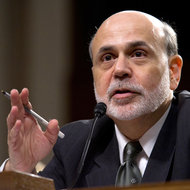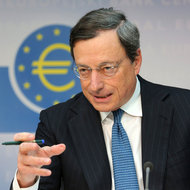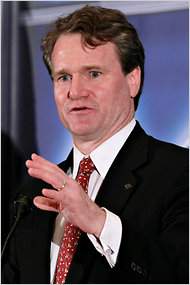 Karen Bleier/Agence France-Presse — Getty ImagesBen Bernanke, chairman of the Federal Reserve.
Karen Bleier/Agence France-Presse — Getty ImagesBen Bernanke, chairman of the Federal Reserve.
Looks like the central bankers just destroyed Wall Street’s 2012 bonus season.
Both the Federal Reserve and the European Central Bank decided this week to hold off on any big new initiatives to stimulate markets and the sluggish economies of the United States and Europe. The lack of action may have a direct and painful impact on the chief source of revenue at investment banks on both sides of the Atlantic. Since the 2008 financial crisis, banks’ bond trading profits have soared when the Fed and the European Central Bank have announced, and then executed, radical moves to revive economic conditions. As that stimulus wanes, that trading income drops off.
The link between Fed stimulus and Wall Street earnings became apparent soon after the financial crisis of 2008. Faced with jittery markets and an economy that was not responding well to meeker modes of stimulus, the Fed bought $1.25 trillion of mortgage-backed bonds, mostly in 2009. In that year, Wall Street bond trading operations, which provide the bulk of profits at such firms, produced some of their strongest results ever. The five biggest trading banks in America together reported $78 billion of bond trading revenue in 2009, the year of “quantitative easing,” the term used for the Fed’s bond buying spree. Goldman Sachs’ fixed-income division reported revenue of $21.9 billion in 2009, up from $9.3 billion in 2008. But in 2010, as the Fed magic wore off, Goldman Sachs’ fixed income revenue fell to $13.7 billion.
Big trading banks are particularly well positioned to profit when central banks act aggressively. The firms help make markets in bonds and derivatives. When the banks’ clients see the Fed take bold steps, they feel encouraged and come off the sidelines to buy more bonds. This increases the amount of business that flows through Wall Street, but it also lifts the prices of the bonds the banks hold, creating profits for the traders. The banks also deliberately increase the size of their bond holdings when they are convinced that central bank actions will lift markets.
Since 2009, the Fed has carried out two additional, but lesser, monetary initiatives. The next time central bank stimulus appeared to have a strong impact on trading profits was in the first quarter of this year. To help European banks fund themselves, the European Central Bank provided cheap, emergency credit to the Continent’s lenders, first in December 2011 and then in February of this year. Investor sentiment rebounded, bonds rallied, and, on cue, fixed-income traders were soon racking up big profits.
 Hannelore Foerster/Bloomberg NewsMario Draghi, president of the European Central Bank.
Hannelore Foerster/Bloomberg NewsMario Draghi, president of the European Central Bank.
Deutsche Bank’s fixed-income revenue was $3.4 billion in the first quarter of 2012, up 225 percent from the fourth quarter’s $1 billion. Société Générale’s jumped 150 percent over the same period. In the United States, Morgan Stanley did particularly well in the first quarter. But soon the markets decided the European Central Bank had not done enough. Bonds sagged, and banks’ fixed-income revenue flagged. Morgan Stanley’s second-quarter fixed-income revenue was down 70 percent from the first quarter, while Société Générale’s halved.
Still, the central banks may yet act with force this year. Both the Fed and the European Central Bank made it clear this week that more forceful initiatives could happen later if economic and market stresses worsen. Many on Wall Street will be hanging on those assurances.
Article source: http://dealbook.nytimes.com/2012/08/02/for-wall-street-real-pain-when-the-fed-fails-to-act/?partner=rss&emc=rss
